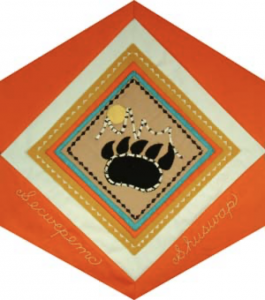Shuswap

The Block
Elder Mary Thomas is a great-grandmother with a host of skills: beadwork, making baby moccasins, tanning deer hides, creating coiled-root and pine-needle baskets and weaving bulrush mats, to name but a few. She began learning these crafts as a young girl, and years of practice are evident in the quality of her work. Mary’s block represents a bear’s paw, made in brown felt with an outline of flattened porcupine quills. A brilliant sun peeks between the mountain top, which is also in natural quills, all appliquéd onto a cotton background.
Cultural Profile
The Shuswap First Nation (who call themselves Secwepmc) have lived in British Columbia’s interior, nestled in the valleys of the Fraser Thompson and Columbia Rivers, since time immemorial. The Secwepmc are an Interior Salish people who speak Secwepemcstin, and like other Interior Salish First Nations groups, their legends and history begin with Coyote. Coyote was sent to set the world in order and to teach the people survival skills, values and principles by which they could live in harmony with the laws of nature. This way of life has been passed on through the generations and remains the foundation of Secwepmc society.
The Secwepmc traditionally lived a semi-nomadic lifestyle, setting up permanent villages during the winter months. For the rest of the year, they travelled in search of rich hunting and fishing areas, and environments that yielded plentiful berries and plants in season. Their winter homes were pit-style houses, built with a wooden log frame over a pit dug into the ground. Their summer homes were easily transportable mat lodges constructed from reeds.
The Secwepmc’s first recorded contact with Europeans occurred in 1793. Fur traders and missionaries began arriving in small numbers about a decade later and forever altered theSecwepmc’s lifestyle. Secwepmc expertise in trapping beaver and other small fur-bearing animals however, made them great partners for the traders. The fur trade and its eventual decline was one of the many factors contributing to the deterioration of Secwepmc traditional culture. In recent decades, though, the Secwepmc have set about re-establishing their language, cultural traditions and art.
The Secwepmc produced fine art work, including everyday items that were decorated with geometric designs. Knife handles, sculpted from elk antlers, and tobacco pipes with bowls are often seen carved with animal faces and stems inlaid with silver. In certain areas of traditional Secwepmc territory, rock faces have been painted with pictographs made from a mixture of red-ochre pigment, salmon roe and animal fat, which increased its durability. The same colouring was used to paint clothing, moccasins, bows and arrows. In addition, porcupine quills, bird feathers, copper, dentalium shells and animal teeth were used to decorate garments and make jewellery.
Celebrations and ceremonies were opportunities for the Secwepmc to come together and socialize. Today, they gather in Kamloops, British Columbia, at the Powwow Arbour––Canada’s largest log structure and North America’s biggest free-standing structure––.for their annual powwow.
Sponsor: Robertson McKenzie Family
